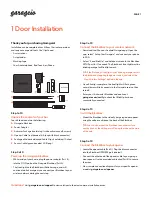
DKC400Y AC Sliding Gate Installation Manual www.solavis.com.au
Copyright © 2008 SOLAVIS
™
Doc: DKC400Y Installation Manual v1.1 page 19 of 22
You are finished, the width for pedestrian opening has been preserved, but the auto-
close function has removed.
Note:
the new width for pedestrian mode has replaced any previous pedestrian mode
opening width which you might have set.
Adjustment of the auto-reverse function:
R
otate the ‘VR1’ knob (See Fig.6 terminal 14) with a screwdriver, the resistance can
be increased (or decreased) by rotating clockwise (or counterclockwise).
If you turn the variable resistor clockwise it will increase the sensitivity. If you turn the
variable resistor counterclockwise, it will decrease the sensitivity.
If the gate fails to top in the event of an obstruction, this means that the sensitivity
has not been adjusted properly. For example if the gate fails to stop, the sensitivity
might not be high enough to recognize that there is an obstruction.
Note:
Please exchange wires ‘V’ and ‘W’ if the auto-reverse direction is wrong. Exchange wires
‘OP’ and ‘CL’ if the limit direction is wrong.
Check
Check the power supply, grounding and wiring before running the device.
Release the gear clutch with the release key to determine whether or not the gate
can be moved manually. If everything is in good working order, tighten the clutch
with the key.
Switch on the power and run the device to ensure that the gate is sliding smoothly.
Adjust the magnet position until the gate opens and closes properly at the intended
positions.
The motor is only designed to work for less than 5 minutes. If is runs continually for
an extended period of time, a thermal protector shut off power to prevent damage.




































